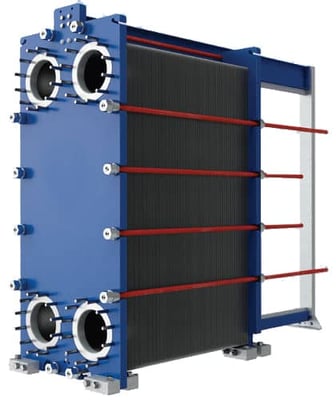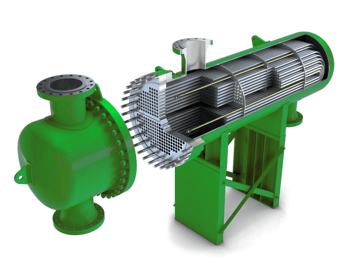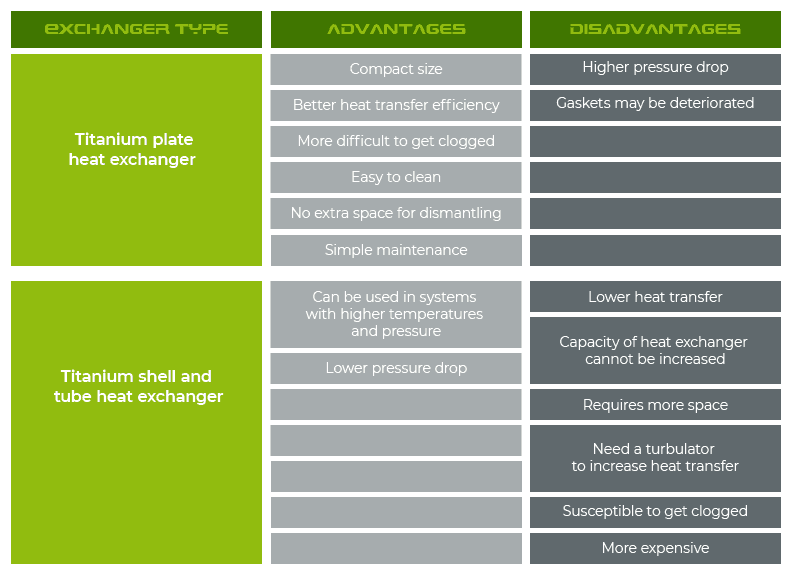Many industrial sites such as oil and gas production facilities and district cooling plants are located on the seashore. These facilities use seawater as a cooling medium if it is technically and economically feasible. The cooling of fluids is a full part of the process through the use of heat exchangers. Direct seawater cooling is normally used to limit cost and save space and weight. The main issue of seawater is that due to the effect of the chlorides contained in its composition, it is highly corrosive to most metals and known alloys. In addition, seawater can contain solid residues, such as particles in suspension or even remains of biological material. Therefore, heat exchange systems that are designed for seawater, must be built with materials that resist corrosion and must have a design that is not affected by the presence of solid waste. Titanium is usually the preferred choice for seawater cooled heat exchangers because of their outstanding corrosion resistance even in hot aerated seawater and their good strength and low density. That means that it can resist in reducing or oxidizing environments, with or without chlorides, and temperatures up to 650 ºC. In addition to high resistance to corrosion attack, titanium owns exceptional resistance to pitting, crevice and stress corrosion. Since seawater is a highly corrosive medium, only corrosion resistant alloys could be considered for its use in seawater heat exchangers. Nickel chromium molybdenum alloys and a highly alloyed stainless are the most common alternatives to the titanium, but their corrosion resistance is much lower and in long life conditions they are not recommended to operate with aggressive fluids as seawater. Titanium heat exchangers are highly cost-effective over the entire life cycle of the equipment. Properly maintained, titanium heat exchangers can operate for decades, making them a very economical choice, in long life conditions. Titanium heat exchangers can:
- Provide an extended service life compared to other materials of construction.
- Eliminate expensive downtime due to equipment failure.
- Provide superior corrosion resistance.
- Deliver high heat transfer efficiency.
Titanium heat exchanger is totally corrosion proof, which means that heat exchanger offer for all working life maximum performance without derating. Given the importance of the use of seawater in current refrigeration systems, this article will evaluate the main heat exchange technologies such as plate exchangers and shell and tube exchangers built with titanium. The advantages and disadvantages of both heat exchange systems will be discussed and it will be concluded which is the most suitable one to operate in district cooling seawater applications.
Titanium plate heat exchanger

The titanium plate heat exchanger is composed of a number of “herringbone” corrugated titanium plates assembled in a plate pack. In appropriate circumstances, titanium plate heat exchangers offer many advantages compared with shell and tube designs. The plate heat exchangers have higher heat transfer coefficients, often three to four times that of a shell and tube exchanger. One of the reasons why plate heat exchangers have higher heat transfer coefficients than shell and tube heat exchangers is because of the turbulent flow produced by the plates’ pattern. This turbulent flow in the titanium heat exchanger is an advantage with respect to the possible presence of solid waste in seawater, the greater the turbulence of the flow, the more difficult it is for the dirt to adhere to it, and therefore, more complicated to have problems due to the accumulation of waste in the exchanger. Due to this turbulent flow in the plate heat exchanger, the pressure drop is higher than in the shell and tubes exchanger. In addition, due to the availability of plate heat exchangers with an extended free channel between the plates, this configuration is able to deal with fluids whose solid waste size is smaller than the depth of the free channel. The particles bigger than the depth of the free channel will be trapped by a filter located upstream the heat exchanger. The small size is also beneficial from an investment perspective, especially when expensive materials as titanium are required. A compact heat exchanger needs less titanium than a shell and tubes heat exchanger, making it much cheaper. The titanium plate heat exchanger is easier to maintain, the thermal capacity is customizable (it is possible to add or remove plates in order to modify the heat transfer ratio), and it is smaller than the shell and tubes heat exchanger. Consequently, they are efficient, compact, cost-effective, and can handle certain fouling fluids. The most efficient design is achieved when the hot and cold fluid flow rates are approximately the same, resulting in similar velocities on both sides of the plates.
Titanium shell and tube heat exchanger

The titanium shell and tube heat exchanger consists of a shell (a large pressure vessel) with a bundle of tubes inside it. One fluid runs through the tubes, and another fluid flows over the tubes (through the shell) to transfer heat between the two fluids. The shell and tube heat exchangers have low heat transfer efficiency compared to the plate heat exchanger. In order to increase the heat transfer ratio, a device called turbulator is added to the heat exchanger. A turbulator is inserted on the tube side of shell and tube heat exchangers and other types of heat transfer equipment. Turbulators are designed to create and maintain turbulent flow and help to increase the tube side heat transfer efficiency. The use of this device makes sense when operating with clean fluids, however, for seawater applications, this device has a negative effect which makes the heat exchanger to get clogged. The size is another disadvantage of shell and tube heat exchangers because they are bigger than the plate heat exchanger. This is the most common type of heat exchanger used in general industry. It is often a confused conviction that this is the lowest cost option. This belief is due to the fact that operating with fresh water, shell and tube exchangers are cheaper than plate exchangers. This is because the plate exchangers are made of stainless steel, while the shell and tube exchangers have copper tubes. Because stainless steel is more expensive and has worse heat conductivity than copper, the plate exchanger is a more expensive option than the shell and tube heat exchanger when both heat exchangers are operating with fresh water. However, operating with seawater, both heat exchangers are built with the same material, in this case, the titanium, being the shell and tube heat exchanger less efficient, much larger, and more expensive option than the plate heat exchanger.
Advantages and disadvantages
Once both heat exchangers have been introduced, the main advantages and disadvantages of plate and shell and tube heat exchanger will be explained:

Conclusions
Titanium heat exchangers are the best option for seawater environments due to their corrosion resistance. The plate exchanger is always the best option due to its compact size, its greater thermal efficiency, its greater difficulty to get clogged and its better price. On the other hand, although a shell and tube heat exchanger could be suitable for seawater applications, this kind of heat exchanger has many disadvantages in comparison with the plate heat exchanger such as its bigger size, its lower heat transfer, its capacity to get clogged, and its higher price.










